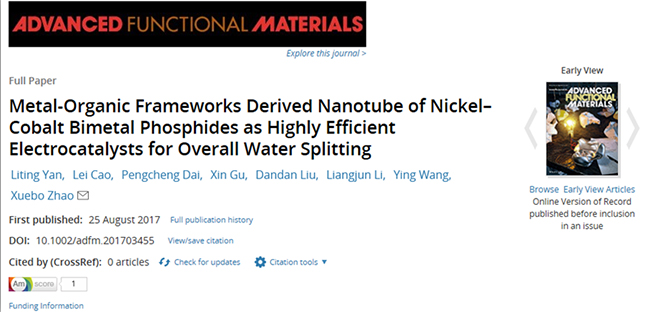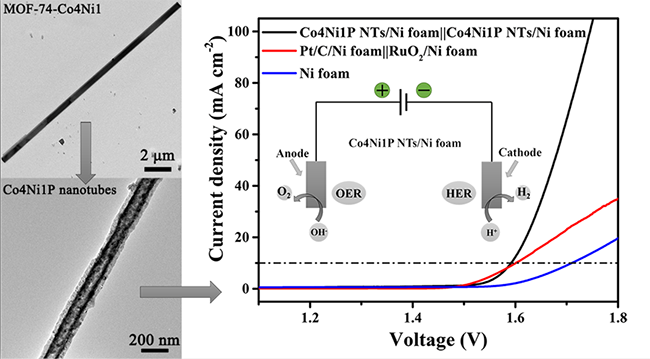Recently, Prof. Zhao Xuebo's group in Institute of Unconventional Oil&Gas and Renewable Energy, China University of Petroleum has published their new research progress about electrolysis of water using noble-metal-free catalyst in the journal Advanced Functional Materials titled Metal-Organic Frameworks DerivedNanotube of Nickel–Cobalt Bimetal Phosphides as Highly Efficient Electrocatalysts for Overall Water splitting. This research presents a new method for preparing Co-Ni-P nanotube as highly efficient electrolyzed water catalyst through the controlled growth of bimetalic metal-organicframework and followed by low temprature phosphorization.


The rapid growth of energy consumption and the corresponding environmental concerns have intensified the demand for renewable and clean energy sources. Electrochemical water splitting is a promising technology to produce hydrogen, which is a renewable, secure, and environmentally friendly source of energy. The electrochemical oxygen evolution reaction (OER) and hydrogen evolution reaction (HER) are the two core redox process. However, both of HER and OER are severely restricted by the reaction kinetics and both of them need high efficent catalysts to promote the overall water splitting efficiency. The precious metal Pt and the oxide RuO2 are the most efficient HER and OER catalysts reported so far, but their high cost and low natural abundance limit their commercialization. Therefore, to investigate and produce a high catalytic noble-metal-free catalyst has become a hot research topic in the field of overall water splitting.
Prof. Zhao and his colleagues discovered that, with precisely change of Co/Ni ratios in the MOF precursor, the MOF crystal could grow along a specific lattice plane due to the coordination difference of Co or Ni with organic ligands, and hence the bimetal metal organic frameworks with different phases were obtained. Then the composite Co4Ni1P nanotube with hollow structures was synthesized via low-temperature phosphorization from an optimized metallic metal-organic framework. The obtained material has the large active surface area, hollow porosity nanotube structure and uniformly distributed carbon substrate. In addition, the optimal regulation of the electronic structure by hetero atoms for this material was beneficial to its activity in the catalytic process. It exhibites better activity than that of integrated counterparts of Pt/C and RuO2 in alkaline solutions and can be used as highly efficient electrocatalysts for overall water splitting. This facile and controllable synthesis strategy can also be extended to other derivatives of metal organic frameworks, which expected to promote a new insight for the potential application of metal organic frameworks in energy related fields.
See more information about the research:
http://onlinelibrary.wiley.com/doi/10.1002/adfm.201703455/full
Source: UPC News Center
Updatetime: 2017-10-24